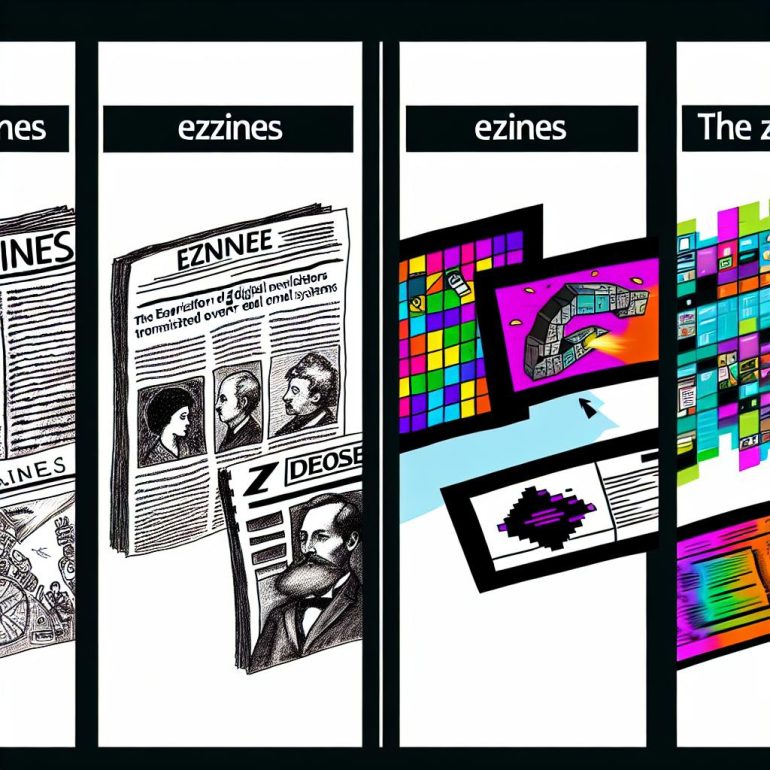The Emergence of Ezines
Electronic magazines, commonly known as ezines, have undergone a remarkable transformation since they first emerged. The word “ezine” is a blend of “electronic” and “magazine,” pointing to a publication format that is disseminated digitally. This concept has its origins in the 1980s, a time when the internet was burgeoning, leading to a shift away from traditional print media to digital platforms.
Early Developments
Ezines made their debut in conjunction with the rise of Bulletin Board Systems (BBS), which played a pivotal role in disseminating digital information. These platforms were instrumental in enabling users to connect, share, and engage in dialogues. Ezines capitalized on these environments by delivering specialized content that was not readily available through mainstream media outlets. The unique nature of these digital publications fostered niche communities and allowed them to thrive.
During the early days, ezines primarily served as a means to distribute literature and other forms of written content that resonated with specific interest groups. As BBS networks continued to grow, they provided an efficient way to share these publications, which were often produced with limited resources. This democratization of content creation and distribution paved the way for further developments in digital publishing.
The Expansion in the 1990s
The 1990s heralded a period of growth for the internet, making it more accessible to the general public. This increased accessibility, combined with the advent of personal computers, contributed to the surge in popularity of ezines. Creators were drawn to this medium due to its cost-effectiveness and extensive reach, enabling them to tap into diverse audiences with varied interests. Consequently, the 1990s saw the birth of countless ezines covering topics from technology and science fiction to niche hobbies and cultural discussions.
This era also marked the introduction of email newsletters as a means of distributing ezines. This new distribution method significantly enhanced the accessibility and reach of content. Compelling designs, direct subscriber engagement, and tailored content were advantages that email newsletters brought to the table, allowing readers to receive updates directly in their inboxes.
Technological Advancements
Technological innovations have been instrumental in shaping the modern ezine. In the early 1990s, the introduction of HTML provided unprecedented opportunities for enhanced design and interactivity. This technology, alongside the burgeoning World Wide Web, enabled ezines to embed hyperlinks, incorporate multimedia elements, and utilize advanced graphics, which vastly improved user engagement.
As the internet matured, so too did the tools available for digital publishing. Content management systems became prevalent, drastically reducing the complexity involved in producing and distributing digital content. These systems empowered creators by allowing them to focus on producing high-quality content, freeing them from the technical complexities previously associated with creating ezines.
The Rise of Web-Based Ezines
The introduction of high-speed internet in the early 2000s was a game-changer for web-based ezines. Enhanced bandwidth capacities facilitated the integration of rich media elements such as videos and interactive features, elevating the reader experience. Additionally, ezines could now offer real-time updates, providing audiences with timely and relevant content.
During this time, reader consumption habits began to shift. The ability to access content on-demand and share it effortlessly via social platforms transformed how audiences interacted with ezines. Readers no longer had to wait for scheduled releases or search through physical copies, marking a significant shift in consumption patterns that ezines quickly adapted to.
Impact of Social Media
The late 2000s and 2010s witnessed the rapid proliferation of social media platforms, which further transformed the ezine landscape. Social networks became integral channels for distributing content and engaging with readers. The viral nature of social media enabled articles to spread swiftly, reaching wider audiences and building communities around specific ezines.
The data generated from platforms such as Facebook, Twitter, and LinkedIn offered invaluable insights into reader preferences, allowing publishers to refine their content strategies and cater more precisely to their audiences. The ability to analyze engagement metrics, reader comments, and share patterns created opportunities for deeper interaction with readers and encouraged the development of content that was more aligned with audience interests.
The Contemporary Era
Today, ezines remain a prominent feature in the media landscape, coexisting with traditional print media and newer digital platforms. They have seamlessly integrated with mobile technologies, ensuring that content is readily accessible via smartphones and tablets. Responsive web design practices are embraced by modern ezines, optimizing the user experience across various devices.
Many ezines have adopted subscription models, offering premium content to loyal subscribers as part of a broader strategy for sustainable content monetization. This shift towards subscription-based models reflects a broader industry trend and underscores the value that readers place on high-quality, targeted content.
Looking Ahead
The future prospects for ezines are bright, buoyed by increasing digital literacy and expanding global internet access. Innovations in artificial intelligence and machine learning open new doors for personalized content delivery, further enhancing reader engagement. As technology continues to advance, ezines are poised to maintain their relevance by adeptly integrating new technological advancements to meet the evolving demands and preferences of their audiences.
In conclusion, ezines have shown remarkable adaptability since their nascent days, leveraging technological and cultural shifts to stay relevant. With the continuous evolution of digital platforms and an ever-growing digital audience, ezines are expected to remain a vital component of the publishing ecosystem, offering diverse, niche, and personalized content to their readers.

